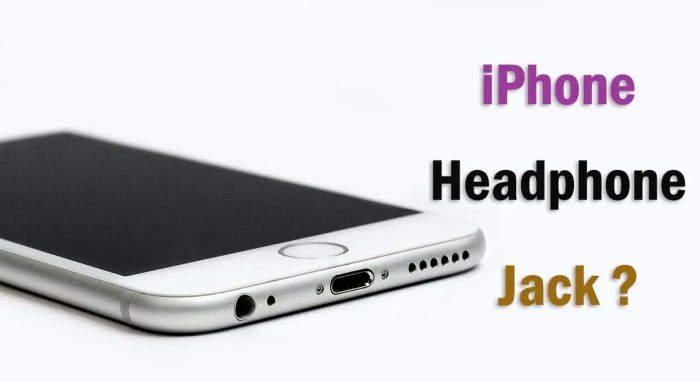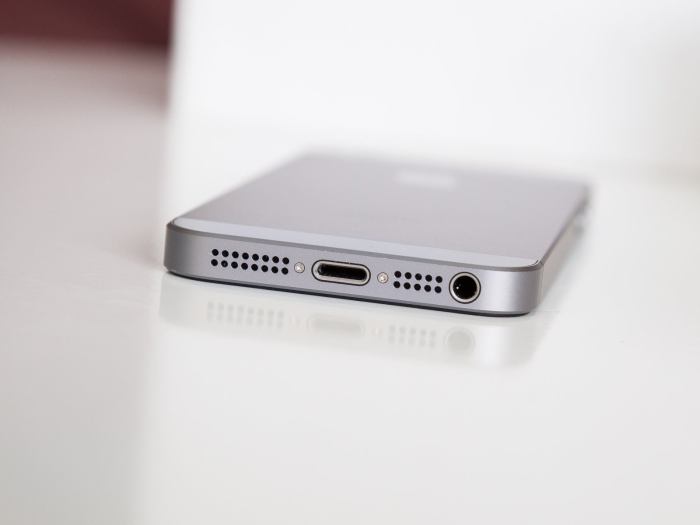Apple’s Rationale for Removing the Headphone Jack
The removal of the headphone jack from iPhones was a controversial decision that sparked much debate. Apple, however, presented a compelling case for the change, citing several reasons that ultimately led to this bold move.
The decision to remove the headphone jack was driven by Apple’s vision for the future of audio technology, which prioritizes wireless connectivity and a more streamlined device design. They argued that the headphone jack was an outdated technology that limited their ability to innovate and create a more user-friendly experience.
Reasons for Removing the Headphone Jack
Apple’s decision to remove the headphone jack was driven by several factors, including:
- Thinner Phone Design: The headphone jack takes up valuable space within a phone’s chassis. Removing it allowed Apple to create a thinner and more aesthetically pleasing design for their iPhones.
- Improved Water Resistance: The headphone jack is a potential entry point for water, compromising a phone’s water resistance. By removing it, Apple could improve the water resistance of their iPhones, making them more durable in everyday use.
- Wireless Audio Revolution: Apple believes that the future of audio is wireless. Removing the headphone jack encouraged users to adopt wireless headphones, which offer greater freedom of movement and a more immersive listening experience.
- Technological Advancements: Apple argued that the headphone jack was an outdated technology that limited their ability to innovate with features like improved audio quality, noise cancellation, and spatial audio. Removing it allowed them to focus on developing more advanced audio technologies.
User Reactions and Criticisms
The decision to remove the headphone jack sparked a wave of mixed reactions from users, ranging from enthusiastic acceptance to fierce criticism. While some users lauded the move as a step towards a more streamlined and wireless future, others voiced concerns about its implications for convenience, compatibility, and accessibility.
Convenience and Compatibility Concerns
Users who criticized the decision primarily raised concerns about the inconvenience and compatibility issues associated with the removal of the headphone jack. They argued that the reliance on wireless headphones or adapters would lead to increased complexity and potential hassle. For example, users would need to ensure their headphones were charged, pair them with their devices, and deal with potential connectivity issues. Additionally, they expressed concerns about the compatibility of existing wired headphones with newer devices, potentially rendering their existing investments obsolete.
“I have a whole collection of wired headphones that I love. Now I’m forced to buy new wireless ones, or use a clunky adapter that gets in the way.” – A user on a tech forum.
Accessibility Issues
The removal of the headphone jack also raised concerns about accessibility for users with hearing impairments or who prefer wired headphones. For individuals with hearing aids or cochlear implants, wired headphones often provide a more stable and reliable connection compared to wireless options. Moreover, some users may prefer the sound quality or functionality of wired headphones, especially in situations where wireless connectivity might be unreliable or inconvenient.
“As someone with hearing loss, wired headphones are crucial for me. They provide a more consistent and reliable connection, which is essential for clear audio.” – A user on a disability advocacy website.
Industry Impact and Trends
Apple’s decision to remove the headphone jack had a significant impact on the smartphone industry, prompting a wave of changes in how manufacturers design and market their devices. The move also accelerated the adoption of wireless audio technology, setting a new trend for the future of headphone usage.
Impact on Other Smartphone Manufacturers
The removal of the headphone jack sparked a debate within the smartphone industry. Some manufacturers, like Samsung and Google, initially resisted the trend, choosing to retain the headphone jack in their flagship models. However, as Apple’s strategy gained traction and consumers became increasingly accustomed to wireless audio, the industry landscape began to shift.
- Initial Resistance: Many manufacturers, particularly those focusing on budget-friendly devices, argued that the headphone jack was a vital feature for affordability and accessibility, especially in regions where wireless technology infrastructure was less developed. They emphasized that the headphone jack provided a reliable and cost-effective option for audio listening.
- Gradual Adoption: Over time, the pressure to conform to the wireless trend mounted. Manufacturers started to embrace the transition, introducing wireless charging capabilities and incorporating features like USB-C ports for both charging and audio output. This allowed them to cater to consumers who had already embraced wireless audio and offered a more streamlined experience.
- Emerging Trends: As wireless audio technology advanced, manufacturers started incorporating features like Bluetooth 5.0 and aptX Low Latency, enhancing the audio quality and reducing lag for a more seamless user experience. The adoption of wireless earbuds with noise cancellation and active noise reduction features further fueled the transition towards wireless audio.
Emerging Trends in Wireless Audio Technology
The rise of wireless audio technology has opened up new avenues for innovation in the headphone industry. Manufacturers are continuously pushing the boundaries of sound quality, battery life, and user experience.
- High-Fidelity Audio: The development of high-resolution audio codecs like LDAC and aptX HD has significantly improved the sound quality of wireless headphones. This allows for a richer and more detailed audio experience, comparable to wired headphones.
- Spatial Audio: The introduction of spatial audio technologies, such as Dolby Atmos and Apple’s Spatial Audio, has revolutionized the way we listen to music. These technologies create a more immersive and realistic listening experience by simulating surround sound effects.
- Advanced Noise Cancellation: Active noise cancellation (ANC) technology has become increasingly sophisticated, effectively blocking out ambient noise and providing a more focused listening experience. This has been particularly beneficial for users who rely on headphones for noise isolation in busy environments.
- Smart Features: Smart features like voice assistants, touch controls, and personalized audio profiles are being integrated into wireless headphones, enhancing their functionality and user experience.
The Evolution of Wireless Audio
The journey from wired to wireless audio has been a fascinating one, driven by technological advancements and the growing demand for freedom and convenience. This evolution has witnessed the rise of various wireless audio technologies, each with its unique strengths and limitations.
The Rise of Bluetooth
Bluetooth, initially developed for short-range data communication between devices, quickly became the standard for wireless audio. It offered a convenient and affordable way to connect headphones, speakers, and other devices without cables. The early versions of Bluetooth were known for their limited range and audio quality, but as the technology evolved, these limitations were addressed.
The Impact of Audio Codecs
The sound quality of wireless audio depends heavily on the audio codec used. A codec compresses and decompresses audio data, balancing sound quality with data transmission efficiency. Bluetooth has supported various codecs over the years, each with its own characteristics:
- SBC (Subband Coding): The default codec for Bluetooth, SBC is known for its simplicity and low power consumption. However, it sacrifices audio quality for efficiency.
- AAC (Advanced Audio Coding): Widely used for streaming services like Apple Music and Spotify, AAC offers better sound quality than SBC at a similar data rate.
- aptX: Developed by Qualcomm, aptX codecs are known for their high fidelity and low latency. They provide a more immersive listening experience, especially for music and gaming.
- aptX Low Latency: Designed for low-latency applications like gaming and video streaming, ensuring audio and video are synchronized.
- aptX HD: This codec supports high-resolution audio, delivering a more detailed and nuanced sound experience.
- LDAC: Developed by Sony, LDAC aims to deliver high-quality audio over Bluetooth. It supports high bitrates and sample rates, allowing for near-lossless audio transmission.
Wireless Headphones: A Comparison
Wireless headphones have become increasingly diverse, offering a wide range of features and price points. Here’s a comparison of some popular options:
| Headphone Model | Codec Support | Battery Life | Price | Notable Features |
|---|---|---|---|---|
| Apple AirPods Pro | AAC, aptX | Up to 4.5 hours (with ANC) | $249 | Active Noise Cancellation, Transparency Mode, Spatial Audio |
| Sony WH-1000XM4 | SBC, AAC, LDAC | Up to 30 hours | $349 | Industry-leading Noise Cancellation, comfortable fit, excellent sound quality |
| Bose QuietComfort 45 | SBC, AAC | Up to 24 hours | $329 | Powerful noise cancellation, balanced sound signature, comfortable design |
| Sennheiser Momentum 4 Wireless | SBC, AAC, aptX Adaptive | Up to 60 hours | $349 | Exceptional sound quality, Adaptive Noise Cancellation, sleek design |
The Future of Audio on Mobile Devices: Apple Explains Headphone Jack Removal
The removal of the headphone jack on mobile devices sparked a wave of change, ushering in an era dominated by wireless audio. This shift has paved the way for advancements in sound quality, convenience, and functionality, but it also presents unique challenges and opportunities for the future of audio on mobile devices.
The Rise of Wireless Audio, Apple explains headphone jack removal
The growing popularity of wireless headphones and earbuds, coupled with the increasing availability of high-quality streaming services, has fundamentally altered how we consume audio on mobile devices. Wireless audio offers several advantages, including freedom of movement, improved portability, and a more immersive listening experience.
- Enhanced Sound Quality: Wireless audio technology, particularly Bluetooth codecs like aptX and LDAC, has made significant strides in transmitting high-fidelity audio, offering a listening experience comparable to wired connections. This has led to a surge in demand for wireless headphones with advanced audio capabilities, such as noise cancellation and spatial audio.
- Convenience and Portability: Wireless headphones eliminate the hassle of tangled wires, making them ideal for on-the-go listening. Their compact size and lightweight design further enhance portability, making them perfect for everyday use.
- Integration with Smart Devices: Wireless headphones seamlessly integrate with smartphones and other smart devices, enabling features like voice assistants, touch controls, and personalized audio settings. This integration enhances user experience and provides a more convenient way to interact with audio content.
Apple explains headphone jack removal – The removal of the headphone jack was a significant moment in the evolution of mobile audio. It ignited a debate about convenience, accessibility, and the future of listening. While the transition to wireless has its challenges, the increasing popularity of wireless headphones and streaming services suggests that the future of audio on mobile devices is undeniably wireless. It remains to be seen what the long-term impact of this decision will be, but one thing is certain: the way we listen to music on our phones is changing, and Apple’s decision to remove the headphone jack was a catalyst for this shift.
Remember when Apple removed the headphone jack and everyone freaked out? Well, maybe they were onto something. They’re reportedly working on their own Snapchat rival, apple reportedly its own snapchat rival , which could mean more focus on video and less on the audio experience. So, maybe those wireless AirPods weren’t just a trend after all, but a strategic move to prepare for a future where audio is just a small part of the Apple experience.
 Standi Techno News
Standi Techno News

